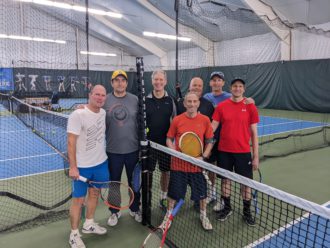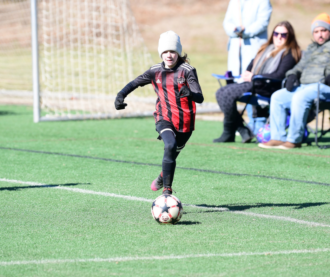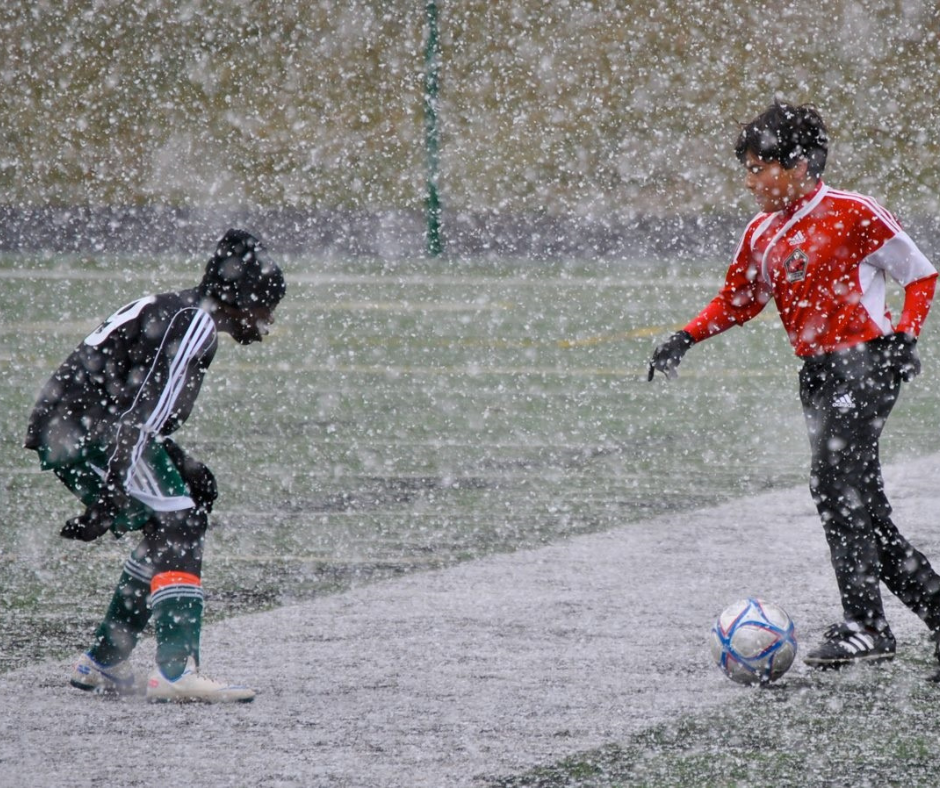When Nathan Malone was growing up in the Asheville area in the 1990s, athletes followed the seasons. At North Buncombe High School, he excelled at winter basketball — which he went on to play as a walk-on at Clemson University — but also competed in football each fall and baseball in the spring.
“That’s just what you did,” he says. “You didn’t play baseball or basketball year-round like you do today.”
Now the league director for the Western North Carolina Youth Sports Association, which offers baseball and softball for players throughout Buncombe County, Malone contends with a vastly different sports environment. Young athletes have become increasingly specialized in hopes of landing a college scholarship or getting discovered by a professional scout. And seasonal rules have largely been abandoned, at least for those who can afford it.
The colder months bring different challenges for various sports. Baseball players with the WNCYSA rely on Asheville Parks and Recreation for fields in spring and summer. But outside of those seasons, because the city doesn’t have dedicated indoor facilities for batters and pitchers, Malone finds himself referring players to such private companies as D-BAT Asheville, The Diamond Mine and 828 Sports Lab.
“It’s expensive. It’s clubs, it’s memberships, things like that. There aren’t a whole lot of [winter] options,” he says. “It just seems like everything has become about how much money somebody can make off of it, unfortunately.”
Local tennis and soccer players don’t have quite as difficult a time remaining active. Their activities are supported by city-owned facilities that remain operational year-round — though limits on those resources mean a certain amount of grit is often required.
Game, set, match
From April through November, Asheville’s tennis community has access to the city-owned Aston Park’s 12 clay courts. Once freezing temperatures arrive, the moisture in the clay makes the surface slick, and the courts can be damaged by use. The city thus closes off the facility until warm weather returns.
“If you are a member of the [Asheville] Racquet Club or the Grove Park Inn, you have indoor courts available where you can still do clinics or play doubles or singles, obviously at cost,” says Debbie Southern, president of the nonprofit Asheville Tennis Association. “But for those that don’t have it, that leaves 11 public hard courts in Asheville that are being shared with pickleball.”
Southern notes that those free courts are available on a first-come, first-served basis and cannot be reserved. And the cost for indoor court time is steep compared with that for Aston Park: In 2022, hourly rates for the city courts were $6 per hour for locals, compared with $61 per hour plus a $15 guest fee at the ARC. Southern says most Aston Park players choose to be strategic and keep their skills sharp on the budget-friendly public hard courts.

“We watch the weather a lot,” she says. “We’re just hardy souls and we look for the [best] days. You might get to play three days in a row, and then maybe there’s four that you don’t play because of the weather.”
On those unplayable days, Southern stays in shape by ramping up her yoga practice and weightlifting at home. She’s also been doing some hiking to stay active and hopes to rejoin the YMCA after dropping her membership early in the COVID-19 pandemic. Combined with semiregular tennis, she’s confident that her transition back to Aston in April will be a fairly smooth one.
“If you have played a lot consistently, and the winter comes and you’re getting to play twice a week, you’re probably keeping your game at a pretty good level,” she says. “It probably won’t be too difficult to come back in the warmer months and be at least where you left off.”
Turf peace
Both ARC locations were once home to indoor soccer, although those fields now have new uses. The two fields that composed the Pepsi Indoor Center, established in 1998, were transformed into four indoor tennis courts when the facility was sold and turned into ARC Downtown. And the one indoor soccer field at ARC South now hosts four indoor pickleball courts.
But Mike Rottjakob, executive director of the Asheville Buncombe Youth Soccer Association, says no such facilities are necessary to keep the sport going year-round.
“We have a pretty moderate climate,” Rottjakob says. “Not that there aren’t days that are too cold for us to be outside, but when John B. Lewis Soccer Complex opened with a massive amount of artificial turf, the need to go indoors decreased.”
Unlike natural grass, which Rottjakob says holds water during the winter, artificial turf dries faster and provides a safer surface on which to play. The city-owned JBL currently has four fields and, according to Lynn Pegg, Parks & Recreation program manager for Buncombe County, three new turf fields will be ready for play at the Buncombe County Sports Park by the end of February.
The increase will help support an already robust local soccer scene that rarely stops. Training and league play have already resumed in ABYSA’s adult recreation league and Highland Football Club competitive program for youths. Once youth recreation participants start practicing the last week of February, nearly 2,000 players will be cycling through the fields.
Rottjakob says activities for the youngest players, those ages 4-6 are more likely to get canceled on a cold, wet day than those for older participants. But overall, he continues, having the artificial turf “has been a game changer for year-round programming.”

The surface also yields some magical moments that indoor soccer can’t provide. “When the field lights are on at JBL and the snow starts coming down, it’s surreal,” Rottjakob says. “There’s been some special, special nights out there, playing soccer in the elements.”
Serving the need
In terms of making year-round play accessible to more people, Southern doesn’t expect local government to build an indoor tennis facility, but she would like to see the number of outdoor hard courts increase. She notes that the city of Greensboro, about three times as populous as Asheville, has nearly 100 hard courts, and she’d prefer that tennis and pickleball use separate spaces.
Similarly, Rottjakob feels that the costs of maintaining an indoor soccer facility are overly prohibitive and that the demand doesn’t currently exist, especially with the number of players that JBL serves.
“If it’s like a community-owned gymnasium or [something similar], then they can find ways to keep it going year round,” Rottjakob says. “But an indoor soccer center has to make a lot of money during a very narrow time of the year, which is why the prices have to be high for running the leagues and so forth.”
When it comes to baseball and softball, however, Malone with the WNCYSA thinks more can be done. He notes that some local parents regularly take their children to facilities in Charlotte or East Tennessee during the winter months to train, seeking an edge they can’t get in WNC. Even indoor athletic facilities that aren’t sport-specific, he says, could go a long way toward helping ballplayers stay competitive during the winter.
“I do feel like local government — city, county and I would even go as far as the schools — has somewhat of an obligation to help provide that,” Malone says. “There’s a lot of baseball, softball and even soccer [components] that can be utilized in a basketball gym.”
Wayne Simmons, program and operations manager for Asheville Parks and Recreation, says that a balance of options in the public and private sectors is important for a vibrant sports community. His department is developing a new master plan over the next year, with opportunities for public engagement. If the demand for more indoor facilities arises through public input, Simmons continues, the city will strive to provide them.
Challenges nevertheless persist. “Management of those spaces, both the initial construction as well as the ongoing upkeep in operations, it’s a little bit more expensive [than outdoor options],” Simmons says. “Here in Asheville, one of the bigger issues is just land for those types of facilities — finding flat land where you could build those types of opportunities if the funding and resources were available.”
Simmons anticipates that the opening of the renovated Dr. Wesley Grant Sr. Southside Center, currently slated for the summer, will help ease the strain on the city’s three other gymnasiums. Though community members can rent these spaces for $75 per hour during operational hours and $100 per hour after hours for team practices, he believes more options are necessary.
“We’re looking at partnerships,” Simmons says. “We’re trying to maintain and strengthen our relationships with Asheville City Schools and Buncombe County Schools for opportunities to share space when it makes sense to provide more access.”
That’s great news for Malone, who fondly recalls winter workouts and practices in public school gyms with his baseball teammates. He says those options have decreased in recent years due to restrictions that both school systems’ representatives say stem from the COVID-19 pandemic. While access gradually returns, many of his players will be shooting hoops this winter and cross-training with another sport.
“We have some kids that swim, and they’re some of our most athletic kids, quite honestly,” Malone says.




PICKLEBALL —– is played many days during the winter— of course- due to this cities innaction– not on dedicated courts-
but where participants bring their own- not really to “regulation” — nets and set them up on tennis courts.
The weather for this sport is maybe around 40 degrees and rising- Oakley / Malvern Hills / Montford– many others play at private clubs..
which may not really be an option for those who can’t afford memberships… who would like the City to build Dedicated Pickleball Courts
for ALL to use– ALL ages- ALL ethnicities- ALL skills- and ALL economic backgrounds- some who really do need to play “for free”.
Players sign up at Playtime Scheduler- I would guess over 100 people play – on average- per day on public and private courts – during winter
Probably more people active playing and more than any other sport trying to play outside in winter.